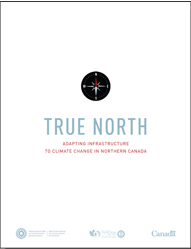True North: Adapting Infrastructure to Climate Change in Northern Canada – Advise
True North highlights the risks to northern infrastructure posed by climate change and the opportunities in adaptation. It casts a light on one of the most critical aspects of adaptation – ensuring that infrastructure is resilient over its lifespan in the face of climate change. Our report shows clearly how we can use existing risk management tools to reduce infrastructure vulnerabilities and adapt more effectively to climate change in Canada’s North.

 On November 26, 2009, the National Round Table on the Environment and the Economy (NRTEE) released its report True North: Adapting Infrastructure to Climate Change in Northern Canada. True North highlights the risks to northern infrastructure posed by climate change and the opportunities in adaptation. It casts a light on one of the most critical aspects of adaptation – ensuring the infrastructure is resilient over its lifespan in the face of climate change. Our report shows clearly how we can use existing risk management tools to reduce infrastructure vulnerabilities and adapt more effectively to climate change in Canada’s North. To do so, we need to do two things: first, make climate change adaptation more of a ‘mainstream’ issue than ever before and, second, build northern capacity to adapt to climate change.
On November 26, 2009, the National Round Table on the Environment and the Economy (NRTEE) released its report True North: Adapting Infrastructure to Climate Change in Northern Canada. True North highlights the risks to northern infrastructure posed by climate change and the opportunities in adaptation. It casts a light on one of the most critical aspects of adaptation – ensuring the infrastructure is resilient over its lifespan in the face of climate change. Our report shows clearly how we can use existing risk management tools to reduce infrastructure vulnerabilities and adapt more effectively to climate change in Canada’s North. To do so, we need to do two things: first, make climate change adaptation more of a ‘mainstream’ issue than ever before and, second, build northern capacity to adapt to climate change.
What do we recommend?
The NRTEE makes the following recommendations to promote the resilience of northern infrastructure and its ability to adapt to a changing climate. Our recommendations have two objectives: first, make existing institutions work better now by mainstreaming adaptation into government policies, processes, and mechanisms and ensuring northern views are “at the table”, and second, build northern climate change adaptation capacity in science and at the community level, so the region is more resilient, selfreliant, and less vulnerable in meeting the challenges of climate change adaptation in the years ahead.
MAINSTREAMING ADAPTATION INTO POLICY
1. Integrate climate risks into existing government policies, processes, and mechanisms.
We can tackle climate change adaptation effectively now by simply utilizing existing policies, processes, and mechanisms more effectively. We don’t need to wait to invent new ones. What’s needed is to take existing knowledge and mainstream adaptation perspectives into what we already do. This means making future infrastructure decisions on a climate-wise basis, integrating longer-term climate factors into planning, funding, building, and management decisions now. Specifically, the NRTEE recommends that:
- The Government of Canada use its infrastructure programming and related federal-provincialterritorial frameworks to leverage the integration of climate risks in new construction and rehabilitation of infrastructure, ensuring that the systems are in place to monitor and report on infrastructure performance.
- The Government of Canada, through the Standards Council of Canada, lead efforts to ensure the effectiveness of codes and standards for infrastructure design, planning, and management to address climate risks, and that this be regularly assessed in light of new climate information.
- Governments and the insurance industry collaborate to examine the role of private insurance in managing climate risks to infrastructure, potential changes in access to coverage of insurance as new climate risk factors emerge, and the need for mandatory disclosure of financial risks that climate change poses to the industry.
- Governments at all levels undertake a collaborative review of current disaster/emergency management frameworks as mechanisms to enable adaptation to climate change on a preventative basis.
2. Ensure northern interests are represented and implicated in the development of climate change adaptation solutions.
- National processes and mechanisms do not adequately account for, or utilize northern perspectives in designing and updating important tools for climate change adaptation. This is essential if this region is going to prepare itself for what’s ahead. Meaningful input from northern practitioners, experts, and communities in infrastructure planning, designing, and building needs to be organized and institutionalized on a regular basis. Specifically, the NRTEE recommends that:
- The Government of Canada promote dialogue and engagement between risk management practitioners (codes, standards, and related instruments; insurance; disaster management) operating in Canada’s North and the climate change adaptation community.
- The Government of Canada consider expanding the relevant national model codes, such as the National Building Code of Canada, to provide direction to northern infrastructure practitioners on the integration of climate risks.
- Governments collaborate with northern infrastructure practitioners to develop design and engineering guidelines, or peer-reviewed best practices, specifically for Canada’s North for each major category of infrastructure.
- Governments highlight expertise and experience in addressing climate risks to northern infrastructure at the circumpolar level, to share knowledge, learn from others, and enforce Canadian leadership as part of Canada’s Northern Strategy.
BUILDING NORTHERN ADAPTATION CAPACITY
3. Strengthen the science capacity and information use in the North to support long-term adaptation efforts.
Science is at the heart of climate change knowledge and trends. We need to know more about the nature and extent of climate change in Canada’s North and how it will affect infrastructure and communities. Data and information of this type can have wider utility and applications beyond government, supporting private infrastructure development and communities’ capacities to adapt quickly and effectively. Specifically, the NRTEE recommends that:
- The Government of Canada invest in expanding the weather and permafrost data stations in Canada’s North that it uses to collect this critical information in support of infrastructure adaptation decision-making needs.
- The Government of Canada ensure the continued investment in climate science and modelling, and in climate change impacts and adaptation research, taking advantage of partnerships with Arctic research institutes and innovative delivery mechanisms.
- The Government of Canada dedicate resources to reliably update and disseminate regionally relevant climate data and information, climate change projections, and climate design values to support infrastructure decisions.
- Governments, the private sector, and research organizations work together to make existing adaptation-relevant scientific and technical data and information more accessible and usable to northern infrastructure practitioners, owners, and operators.
4. Build community capacity to address climate risks to northern infrastructure and take advantage of opportunities.
Communities in Canada’s North need stronger adaptive capacity to deal with climate change. The vulnerability of northern infrastructure and related services is plainly evident. Reliable infrastructure is central to sustainable regional development and human security. Yet, in many northern communities, the capacity to assess and manage the risks to infrastructure posed by climate change, as well as to seize opportunities, is very limited. Specifically, the NRTEE recommends that:
- Governments continue to support community-based infrastructure-risk reduction through activities such as building awareness of the linkages between disaster management and climate change adaptation, critical infrastructure mapping, and developing and tracking of vulnerability indicators.
- Governments support regional innovation in Canada’s North by encouraging the development of new technologies and materials adapted to cold climates and enabling their commercialization.
- Governments work together to identify gaps and support regional skills development to address infrastructure needs in a changing northern climate, including ensuring local capacity exists to conduct risk assessments, and deploy and enforce risk reduction measures and standards locally and regionally.
- Governments, the private sector, communities, and research organizations consider how to further tap into traditional and local knowledge as a unique contributor to building community and regional capacity for adaptation
Key Observations From True North
- The North is susceptible to breakdowns in infrastructure because of a lack of back-up systems for key services like hospitals, airports and communications, among others.
- Codes, standards and related instruments often lack specifications for northern construction.
- Early springs can cause ice roads to melt sooner, forcing individuals, companies, governments and others to use more expensive forms of transportation, like air-lifts.
- Melting permafrost can compromise the integrity of a large number of forms of infrastructure, including buildings, pipelines and industrial waste dumps.
- In some parts of northern Canada, the mean annual temperatures that are reported in the design values for some codes, standards and related instruments are 2°C behind current averages.
- Climate change issues are a significant challenge to the budgets of northern governments, which must often make difficult choices on where best to expend public dollars.
- Better co-ordination among all levels of government can save money and make for smoother planning processes.
- Of Nunavut’s 26 communities, 25 are located on coasts, making them more vulnerable to increased sea levels and wave action.
- Adjusting liability insurance policies can create incentives for builders to modify construction practices aimed at making infrastructure more resilient.
- Changes in weather patterns, especially warmer temperatures, can cause difficulties for remote communities reliant on winter roads for the supply of goods and services.
- In the absence of reliable climate data and information, infrastructure builders don’t always have the necessary tools to guide their decision-making to ensure that new construction will withstand the realities of changing conditions (e.g. snow loads on roofs).
- Infrastructure practitioners and other users of climate-related data for infrastructure design and construction will need to recognize the limitations of basing decisions on climate conditions projected by models
- Implementing better codes, standards and related instruments such as guidelines, will allow Canada to take advantage of new opportunities such as the commercialization of new materials and technologies adapted to cold climates.
- Ensuring the resilience of northern infrastructure to a changing climate is paramount to the safeguarding of national and northern security interests.
CANADA’S NORTH
Canada’s North is on the frontline of climate change. Nowhere else are the effects and stakes of failing to adapt to climate change so high.
Sorry, either Adobe flash is not installed or you do not have it enabled























